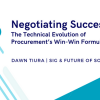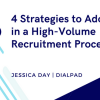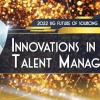It would be far too simple to craft an “us versus them” story when it comes to different generations in the workforce today. For example, one could say older workers, like Baby Boomers, are outdated, and Generation Z, today’s youthful college graduates, are the tech-savvy heroes. Or perhaps the Boomers are experienced and hardworking while Gen Z are tech addicted and anti-social.
The truth is, in most companies, you’ll easily find four to five different generations working side-by-side. Nuances are far more complicated than these stereotypes would suggest.
In the not so distant past, the media was packed with stories about disputes between “Boomers” and “Millennials.” Discussions around how avocado toast has contributed to a lack of younger-generation home buying have become part of pop culture. These days though, while Millennials are still a compelling factor in the workforce, it is often the two age extremes of today’s workplace, Baby Boomers and Generation Z, that are pitted against each other.
Balancing the management, retention, and engagement across these generations can be a considerable challenge since it’s no surprise each generation wants and needs to be treated differently. Creating this balance will reward any department, procurement included, with a diverse and formidable workforce.
Success Comes From Understanding
In 2019, the first Gen Z’ers (born roughly between 1997 and 2010) who completed a four-year college degree began working. By the end of 2020, they are predicted to make up around one-quarter of the working population! Notably, Gen Z is the first generation to have lived their entire life with the internet and is often touted as the most technologically capable.
Baby Boomers, on the other hand (born between 1944 and 1964), are known for their strong work ethic, commitment to getting things done, and longevity on the job. Goal-centric and team-oriented, they can clash with the more independent generations. Baby Boomers tend to reward employers with loyalty, extra hours, and discipline.
To get the best out of what workers have to offer, it is imperative to understand what they each need to be satisfied in their jobs.
Attracting Gen Z to Procurement
This generation craves flexibility, is technologically inclined, and keeps an open mind. Gen Z values employers that have substantial diversity and inclusion policies, and that champion diverse and sustainable suppliers. Like Millennials, Gen Zers are willing to grow with their careers and tend to seek stability.
Despite popular belief, they have seen an abundance of societal changes and economic uncertainty. They want job security, access to 401Ks, and health insurance.
Altitude’s recent study revealed Gen Zers take around eight seconds to decide whether to engage with a piece of online content, such as a job ad. If your organization’s website and social platforms are lacking or seem dated, they probably will not engage. Don’t expect Gen Z staff to fit in well inside of functions that have not made moves towards digital transformation or are weighed down by bureaucracy.
Attracting Experienced Professionals
It’s likely there is already a strong stable of Baby Boomers in your organization, and indeed it’s essential to be aware that experienced professionals are a long-term investment. According to AARP, many workers intend to work past 65, the typical retirement age, and into their 70s and 80s.
Older professionals also tend to cost less over time than their Millennial counterparts, making them a worthy investment. A report by Gallup uncovered that 21% of Millennials claim they have changed jobs within a year, which is three times the number of non-Millennials who report the same.
To attract them to your function, however, may mean relying on more conventional measures. Baby Boomers commonly have more traditional ways of searching for a job: face-to-face networking, job boards, and ads.
Bridging the Generation Gap
With the four main generations making up the modern workforce—Baby Boomers, Gen-X, Millennials, and Gen-Z—it’d be foolhardy not to leverage each group’s different skill sets and create mutually beneficial connections between them for a cohesive team.
Working together effectively starts with mindset.
Smart hiring managers and leaders understand they must approach each generation differently, using strategies to help bridge the gaps. Creating opportunities for collaboration, avoiding blanket policies that alienate some age groups, and establishing consistent expectations for results, while offering flexibility in how those are accomplished, assist in closing age gaps and getting your team working toward a common goal.
Mentorship is Valuable for all Workers
With younger generations, many don’t yet have the experience or skills to step into leadership positions.
Encouraging experienced professionals to mentor and guide younger generations will help all groups understand each other and transfer essential knowledge. Of course, mentors often learn just as much as their mentees, making mentorship a priority that benefits workers of all ages.
Customize Rewards and Recognition
Each generation wants to be acknowledged for their work in different ways. Baby Boomers are known to expect pay raises and promotions. Subsequent generations often covet more one-on-one engagement from their boss and perks like flexible benefit plans, generous vacation time, and the option to work remotely.
That’s why it’s critical to experiment with, and offer, a diverse array of employee rewards.
Consider Cross-generational Training
Sixty percent of companies are experiencing cross-generational tension, according to a recent survey. Clearly, cross-generational training should be a priority for forward-thinking companies and leaders.
This type of training informs employees about the advantages each generation brings to the workplace and helps them prepare for the hiring and talent challenges ahead—ultimately allowing them to learn to work together with less conflict.
Avoid Ageism
There are plenty of stories about workers in the Baby Boomer range being cut loose while younger workers survive. While this phenomenon can be partially explained by money (experienced pros naturally earn more than those just entering the workforce), there’s no denying some aspect of ageism. The most common stereotype, of course, is older workers don’t understand modern technology and are too set in their ways to adapt.
Ageism is a concern for many professionals in procurement (and undoubtedly most other functions) who are looking to advance their careers, move into C-suite positions, or simply need to continue working to make a living.
In actuality, older workers can learn quickly. With professionals who’ve been in the industry for many years, there is a high chance they have excellent learning habits. That experience means your training needs (and cost to the company) could be lower.
To put it simply, a diverse workforce built on literal generations of knowledge and experience can be a significant benefit to companies. A company that hires across generations is better equipped to attract that same level of diversity among their clients and customers. If companies are willing to learn more about generational strengths, needs, and how to respond to them, it benefits all employees and the bottom line.







